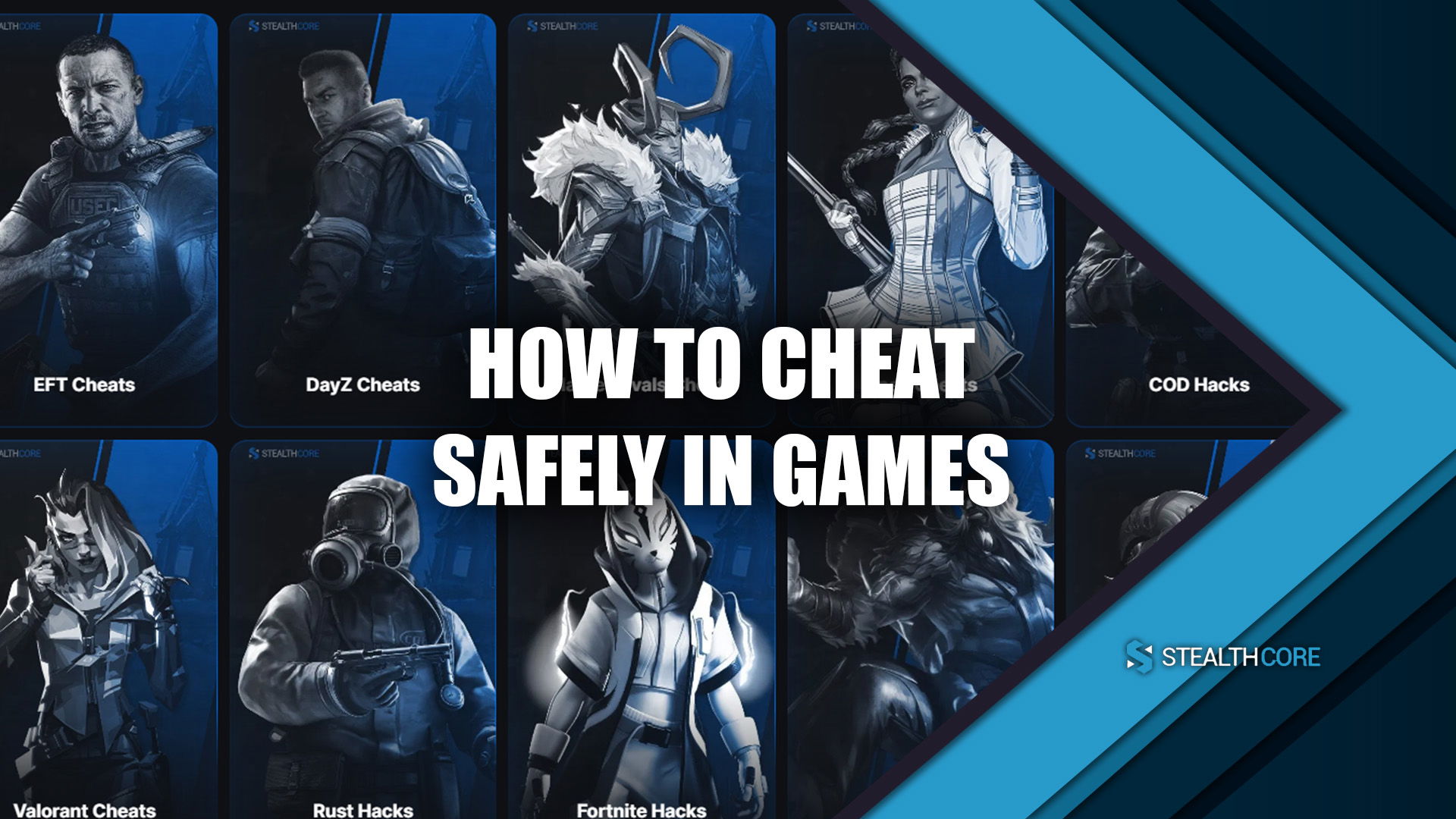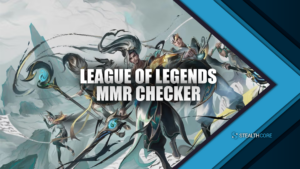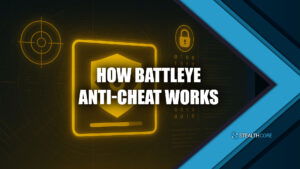Get an edge while remaining stress-free by learning how to cheat safely in games.
Cheating in modern multiplayer games isn’t what it used to be. Anti-cheat systems have evolved into high-tech watchdogs, some using AI, server-side analytics, and kernel-level access to your machine. Getting banned today can mean more than just losing an account; it could mean facing a full system ban, locked hardware IDs, or permanent exclusion from competitive titles.
At StealthCore, we’ve helped thousands of players cheat safely for games like Tarkov, Valorant, and Rust. We’re not here to promote reckless behavior, we’re here to guide you on how to cheat safely, how anti-cheat works, reduce your detection risk, and preserve your accounts.
If you’re looking for real, tested, and safe cheating tips backed by experience, you’re in the right place.
How to Cheat Safely in Games
Learning how to cheat safely in games means understanding both the tools and the behaviors that keep you under the radar.
Many players assume that using a paid or “undetected” cheat guarantees safety, but that’s only half the equation. What truly matters is the strategy behind it. Cheating recklessly, even with the most advanced tools, will eventually get you flagged.
Here’s a simple breakdown of what this guide will teach:
- How anti-cheat systems really work
- What to look for in a cheat provider
- Safe cheat usage habits that avoid triggering detection systems
- Cleaning your system properly after bans
- Staying undetected long-term
Combining smart habits with the safest legit cheat settings is your best long-term strategy. Think before you toggle, understand your enemy (the anti-cheat), and treat each session like a calculated risk, not a free-for-all.
If you want to cheat without drawing attention, bookmark this guide. And if you’re looking for tools, check out these undetected cheats for Escape from Tarkov.
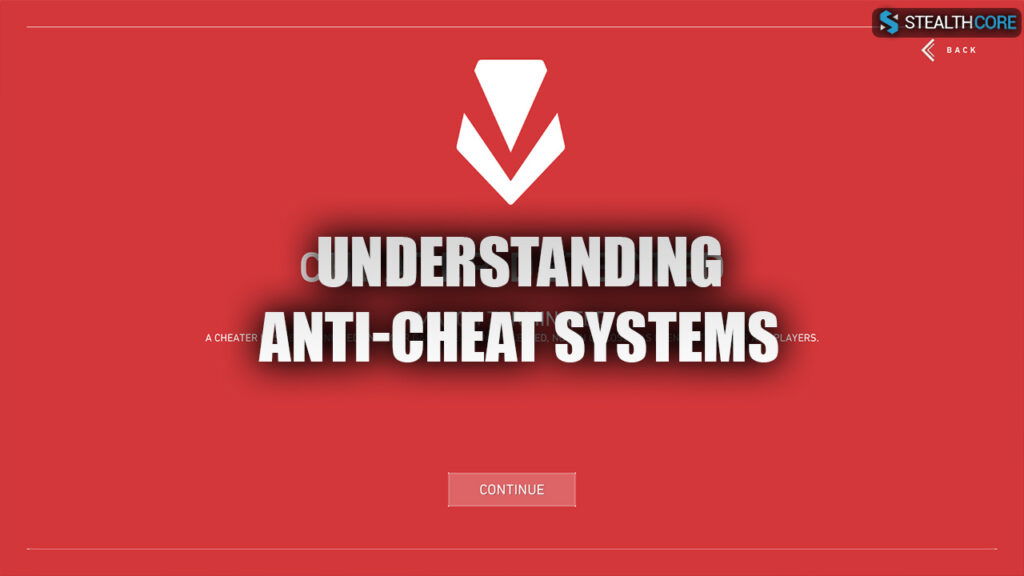
Understanding Anti-Cheat Systems
Before using any cheat, you need to understand what you’re really up against. Anti-cheat systems come in various forms and keep evolving constantly:
1. Kernel-Level Anti-Cheat
These run even before your operating system finishes booting. Examples include BattlEye and Vanguard (Valorant). They scan everything from drivers, kernel processes, to background apps and services. Some kernel-level systems actively look for signs of cleaning cheat traces, so simply deleting logs or spoofing your hardware ID isn’t enough.
They track lingering artifacts that can link you to cheating, meaning stealthy, clean coding is critical.
2. Server-Side Detection
Games like Rust and Escape from Tarkov monitor your in-game stats on the server side. If your stats start looking off, like nailing headshots way too consistently or reacting to gunfire super fast, you could catch the attention of the system.
Even if you’re not using obvious cheats, the server logs can still mark your stats as suspicious. This can lead to bans without clear explanations, leaving players confused about what happened or how to fix the issue.
3. AI Replay Reviews
This is the scariest part. Systems like Overwatch in CS:GO and AI-driven replay reviews in Tarkov analyze aim patterns, movement, and overall gameplay behavior.
They can identify unnatural tendencies that even the best cheats can’t mask. These AI tools are becoming smarter and faster, and less forgiving of suspicious gameplay, even if no direct cheat code is detected.
Common Myth
“Spoofing is enough to stay safe.” False. Spoofing your hardware ID or IP can reduce some risks, but it’s far from a full-proof shield. If your gameplay behavior looks suspicious or triggers server-side or AI detection, you’re still at risk of bans.
We’ll cover this further in our upcoming deep dive article: how anti-cheat systems detect cheaters.
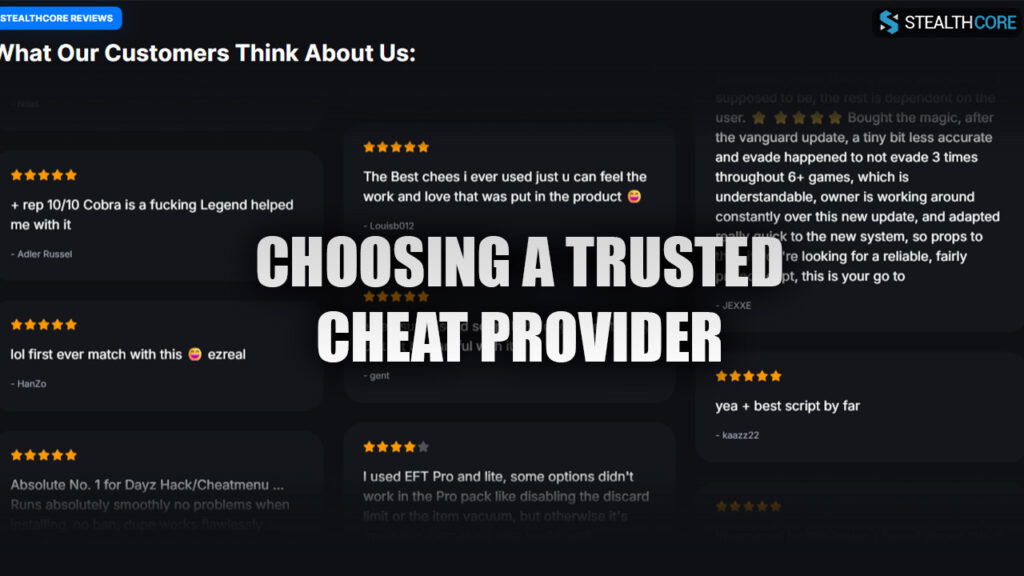
Choosing a Trusted Cheat Provider
If you’re downloading free or public cheats, you’re basically begging to get banned. Most bans happen because of one or more of these reasons:
- Poorly maintained, reused, or outdated codes
- Public signature detection
- No stealth injection
- Lazy dev teams who don’t test on fresh systems
That’s why picking the right provider is crucial if you want to avoid getting banned while cheating. A reputable provider doesn’t just focus on cheat performance, they’re also focused on stealth, system compatibility, and even HWID ban prevention.
Smart providers will rotate loaders, obfuscate their tools, and guide you on how to reset traces between uses. So, ask yourself:
- Do they test each build in a clean environment?
- Do they update regularly after anti-cheat patches?
- Is the loader protected and obfuscated?
- Are cheat functions customizable for legit-style play?
- Do they offer guides on spoofing and system cleaning?
- Do they have legit user testimonials on cheat effectiveness?
Don’t trust a cheat that looks flashy but lacks a serious focus on safety. A good provider is lowkey, quiet, and focused on keeping you under the radar, not impressing you with GUI animations.
For example, our Valorant cheats are tested on fresh installs daily to ensure stealth and performance.
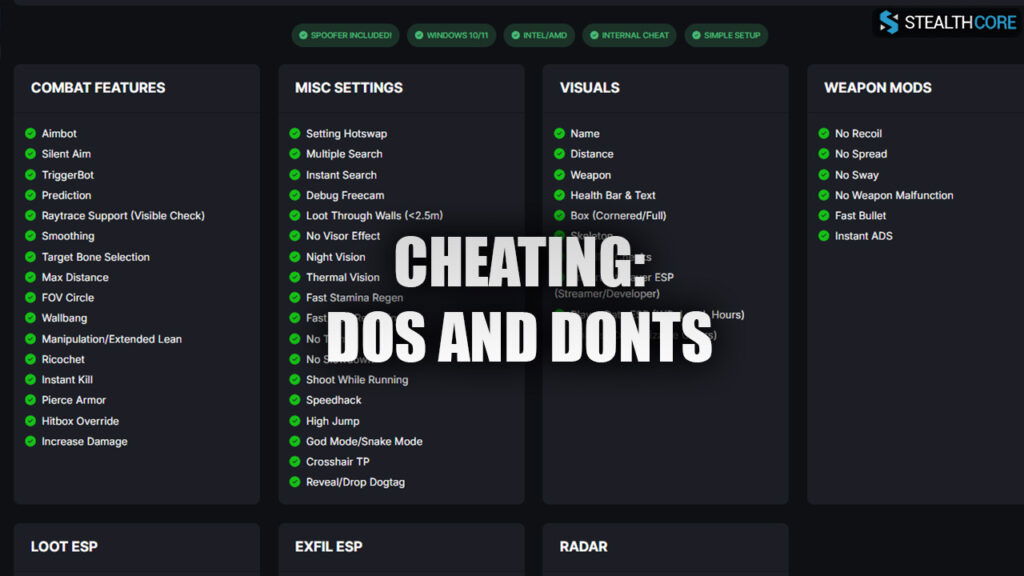
Using Cheats Safely – Do’s and Don’ts
Let’s get into the real meat of safe cheating habits. This is the difference between a cheater who plays for years and one who gets banned in a week.
This is not only about the cheat you use, but also about how well you blend in, manage your setup, and avoid predictable behavior.
DO:
- Use legit aimbot settings: low FOV (2–4), 20+ smoothing. No snapping or flicking.
- Check your cheat’s detection status before every session.
- Use safe injection methods before launching the game; never inject mid-match.
- Play naturally: miss a few shots, don’t track through walls, and vary your playstyle.
- Keep your configs updated regularly based on your provider’s latest safe settings.
- Use alt accounts to test new configs or builds before loading them on your main.
- Rotate game accounts occasionally to reduce long-term stat tracking and suspicion.
- Mimic your rank’s average performance, don’t overperform every game.
- Monitor your in-game stats like accuracy and K/D ratio to make sure they’re not unrealistic.
DON’T:
- Rage toggle mid-fight or snap instantly to targets through cover.
- Use outdated, public, or shared config files, they’re often flagged.
- Brag about your cheats in game chat, forums, or voice, it draws unnecessary attention.
- Cheat during peak hours, events, or ranked tournaments where manual reviews are more likely.
- Repeat the same movement patterns or drop high-kill games every match, behavioral tracking exists.
- Assume “undetected” today means safe forever, cheats can be silently flagged at any time.
- Skip updates from your cheat provider, missing a patch could get you banned.
- Ignoring red flags like sudden crashes, disconnects, or increased reports, these can be early warnings.
Treat every session like it could be monitored. Caution and discipline are your best tools for long-term survival. Be deliberate, stay informed, and never get too comfortable.
Before launching, always check the cheat detection status page on our site.
What StealthCore Can and Can’t Protect You From
Here’s where we get honest. Even with the best tools, some risks can’t be avoided. No StealthCore safety guide is complete without acknowledging the limits.
What We Can Protect You From:
- Detection via outdated signatures
- Improper injection techniques
- Unsafe loaders or public cheats
- Static config traces
- Known detection vectors through shared cheat paths
Risks We Can’t Cover:
- Player reports (killcams, spectating)
- AI replay reviews that study aim patterns and camera movement
- Server-side stat analysis (e.g., 90% headshot rate or insane K/D)
- Virtual Machine usage, easy red flag for many anti-cheats
- Hardware bans tied to reused or flagged HWIDs
Tips to Reduce Risks:
- Avoid rage gameplay. You’re not aimbotting in a LAN party, subtlety is survival.
- Don’t get clipped by streamers or in public highlight kills. Avoid high-traffic areas if possible.
- Use safe, minimal configs. Lower FOV and legit settings = longer lifespan.
- Don’t log in to banned accounts from the same PC or IP without cleaning traces.
- Keep your system clean and isolated: one game, one use-case, one config.
- Regularly spoof, reboot, and clean post-bans for real HWID ban prevention.
StealthCore can give you a huge edge, but in the end, it’s your habits that decide if you stay in the game or get flagged.
That’s why you have to be smart. Don’t rage. Don’t show off. After all, there is a difference between undetected and undetectable cheats. The latter doesn’t exist, by the way.
And if you’re worried about detection based on performance stats, review our headshot ratio safety tips.

Cleaning Your System After a Ban
So, you got banned. Don’t panic. But don’t get into the cleanup either. Forget about those “cheat remover” tools, only a full Windows reinstall is safe.
Why is this necessary? Modern anti-cheat systems like BattlEye and Vanguard don’t just scan your game files, they dig deep. They leave behind persistent artifacts such as:
- Registry entries that track cheat usage
- Hidden file traces scattered across system folders
- Hardware ID (HWID) blacklists tied to your machine
- Logs stored in various directories that survive simple deletes
What You Need to Do:
- Reinstall Windows fresh from a clean, official ISO download
- Format all storage drives involved, or at minimum, your OS partition
- Flash your BIOS if your motherboard supports it, some bans go deep
- Use a reliable HWID spoofer to mask your hardware identity before re-entry
Partial cleaning methods or just deleting cheat folders won’t cut it. A proper Windows reinstall after ban wipes out these deeply embedded traces and gives you a fresh start, drastically reducing your chances of immediate re-detection. This step is the gold standard for anyone serious about safe cheating.
For banned users, windows reinstall is the only safe solution.
Best Practices to Stay Undetected Long-Term
Want to cheat for years, not just weeks? It’s all about consistent, smart habits that keep you off the radar. Follow these long-term survival tips:
- Avoid rage toggling, even when you’re tilted. Erratic, superhuman plays get noticed fast.
- Switch configs regularly every few sessions. Reusing the same patterns makes detection easier.
- Play during off-peak hours to reduce the chances of being spectated or recorded by vigilant players or streamers.
- Use a secondary account strictly for riskier cheats or experimental settings, never your main.
- Keep your gameplay realistic: miss shots occasionally, move naturally, and don’t act like a robot.
- Never brag about cheating or share clips of suspicious plays online.
- Clear cheat traces consistently using the StealthCore safety guide to avoid buildup of detectable footprints.
- Limit cheat use in ranked or tournament matches where scrutiny is higher.
- Monitor community reports or updates from cheat providers to adjust your tactics promptly.
Long-term undetected cheating is a marathon, not a sprint. Your safest bet is to blend in, stay cautious, and constantly adapt
See our full list of long-term cheat safety practices to stay under the radar. Fof help with personalization, check out our safe config templates.
Conclusion
Cheating doesn’t have to be reckless. When you understand how to cheat safely in games, you minimize risk, preserve your main account, and stay miles ahead of lazy players who get banned every other week.
Use trusted providers. Respect anti-cheat systems. And above all, cheat smart and not loud.
Explore our blog for more tips on how to cheat safely, clean your system, and play smarter, not riskier.
Need help? Join our community or contact support anytime.

